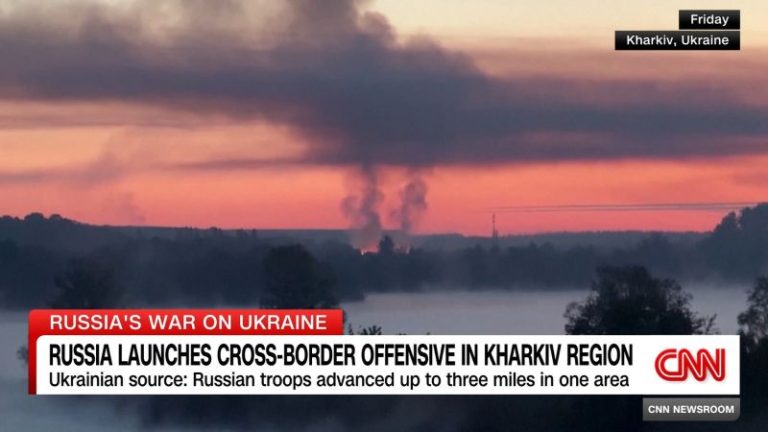Russia’s military claimed to have captured five villages in the Kharkiv region on the border with Ukraine as part of a new offensive, while Ukrainian authorities said it was repelling the attacks and “fighting continues.”
Russia began its surprise cross-border attack on Friday, making two assaults inside northern Ukraine on Friday, in what President Volodymyr Zelensky called a “new wave of counteroffensive actions” by Russia.
The precise goal is unclear but Moscow may be trying to create a buffer zone to reduce Ukrainian attacks on Russian territory or try to wear down and divert the attention of Kyiv’s already thinly stretched forces.
In a statement Russia’s Ministry of Defense claimed a new military grouping called Sever (North) had “liberated” several villages, wording that reflects Russia’s denial of Ukrainian statehood.
“As a result of offensive operations, the units of the Sever Group of Forces have liberated Borisovka, Ogurtsovo, Pletenevka, Pylnaya, and Strelechya,” the statement said, adding that Russian troops had also taken the village of Keramik in the Donetsk region, further south.
Ukrainian forces, meanwhile, said it continued efforts to repel the stepped-up Russian attacks while hundreds of Ukrainian civilians have been evacuated from the northern Kharkiv region.
Ukraine’s Oleh Syniehubov, Head of the Kharkiv Regional Military Administration, disputed that the five villages in the Kharkiv Region had been captured in a statement on Saturday.
“Heavy fighting continues in Strilecha, Pylyna, Borysivka, in the area of Oliynykove and Ohirtseve. The fighting continues in the area of those settlements that were actually in the ‘grey zone’ […] There is no threat of a ground operation for Kharkiv. The Defense Forces are doing everything possible to hold their positions. All government agencies are working on the ground,” Syniehubov said.
The grey zone represents territory currently contested rather than under full Russian or Ukrainian control.
At least three people died as a result of Russian strikes on Kharkiv region overnight, according to the head of the region’s military administration.
Russia’s recent efforts have largely been focused in the east, where it has taken advantages of Ukrainian manpower and weaponry shortages to make small advances. Its forces attacked Kharkiv region after the full-scale invasion began in 2022 but were forced out in a Ukrainian counteroffensive later that year.
In a separate development, a fire briefly broke out at the Volgograd oil refinery, the largest oil refinery in southern Russia, after a Ukrainian drone attack overnight into Sunday, according to the region’s governor.
“On the night of May 12, air defense and electronic warfare forces repelled a UAV attack on the territory of the Volgograd region,” Andrey Bocharov said in a post on Telegram.
“As a result of the consequences of a UAV crash with subsequent detonation, a fire broke out at the Volgograd Refinery site,” he said.
The fire has been extinguished and there were no casualties, he said.

